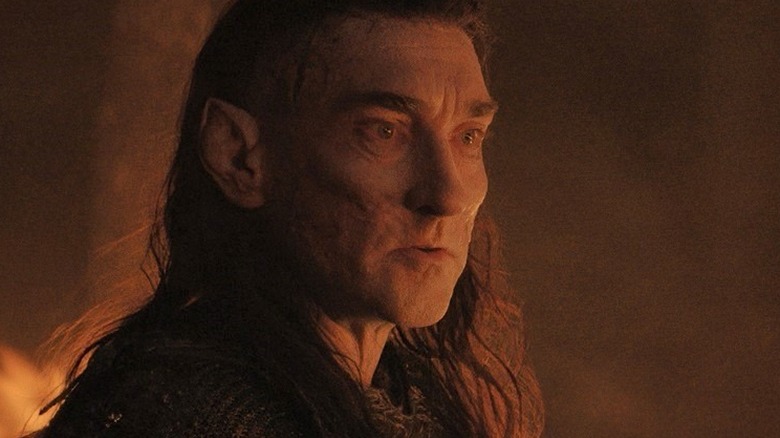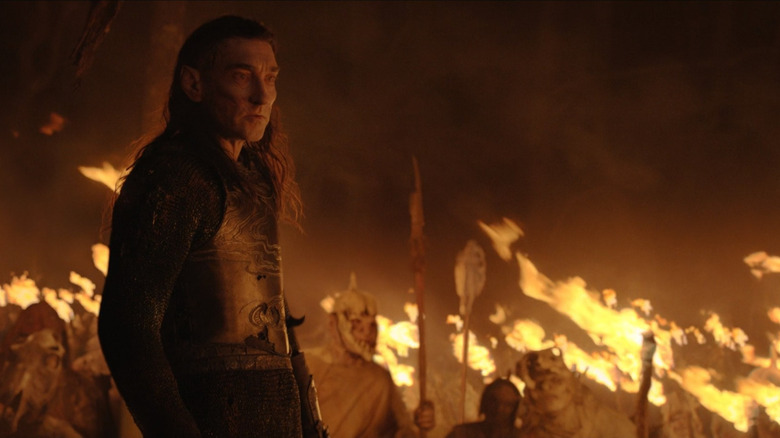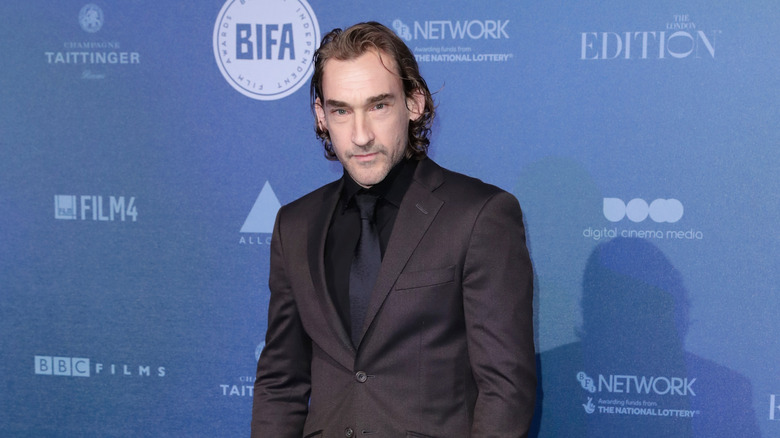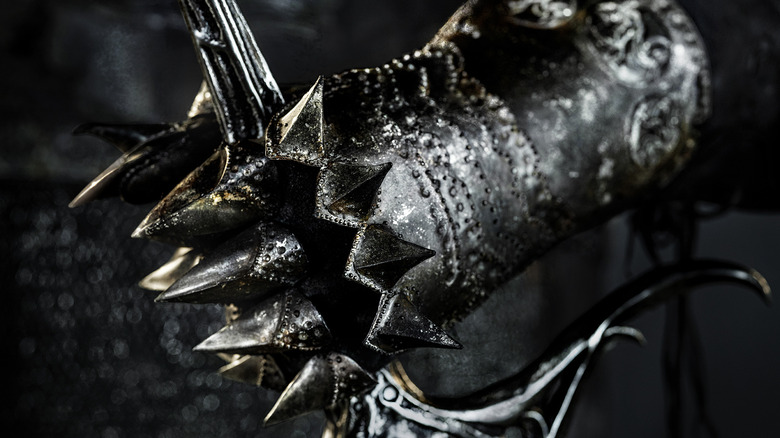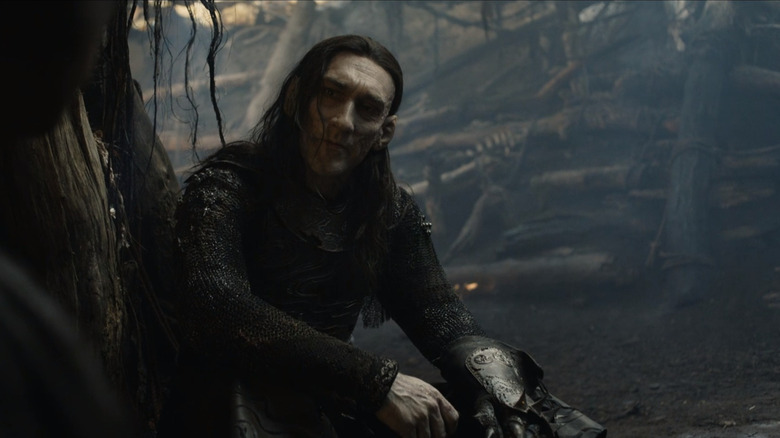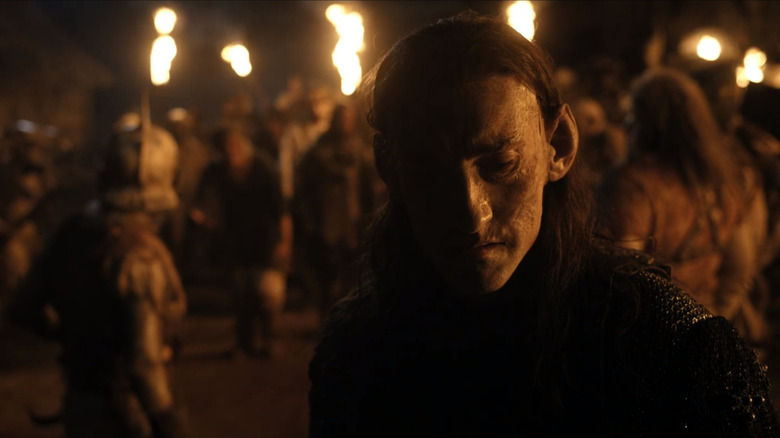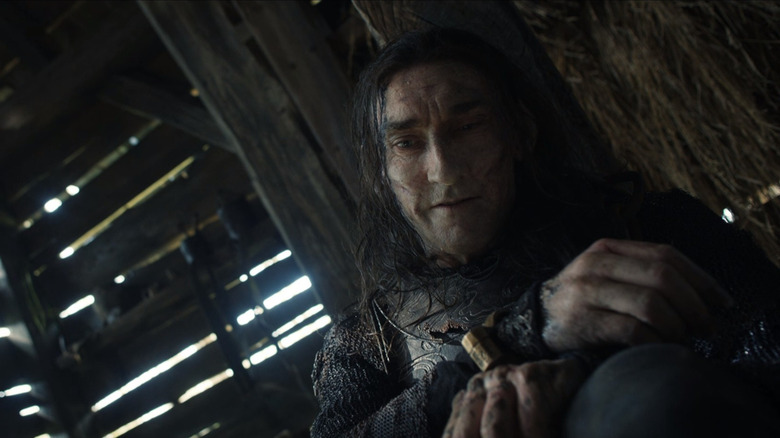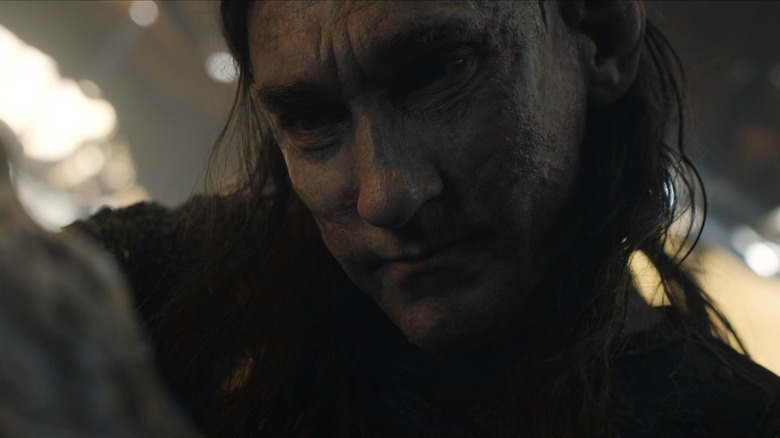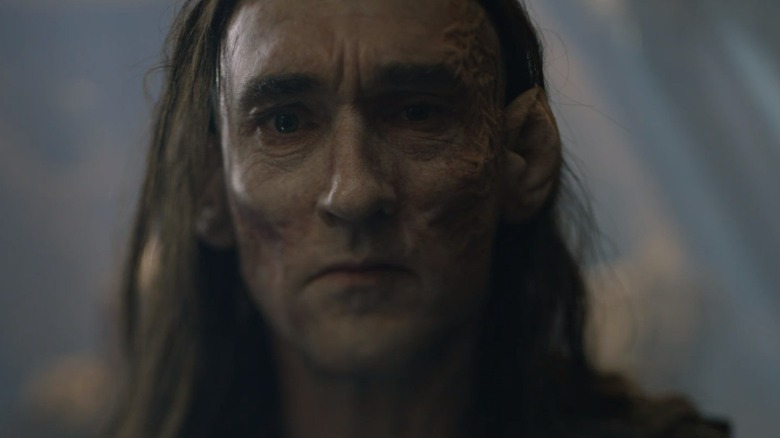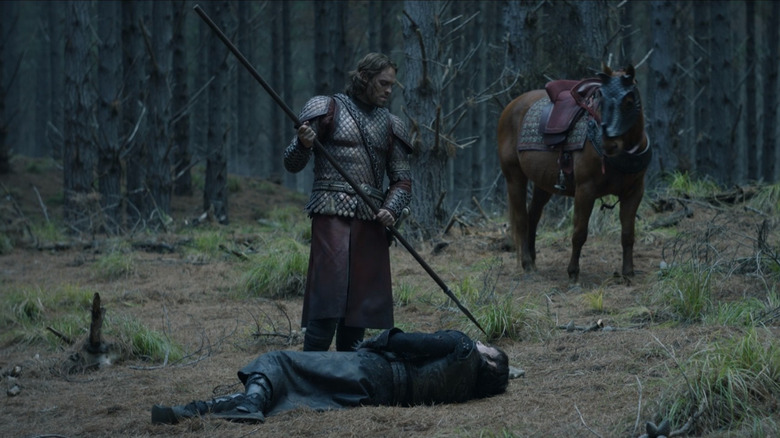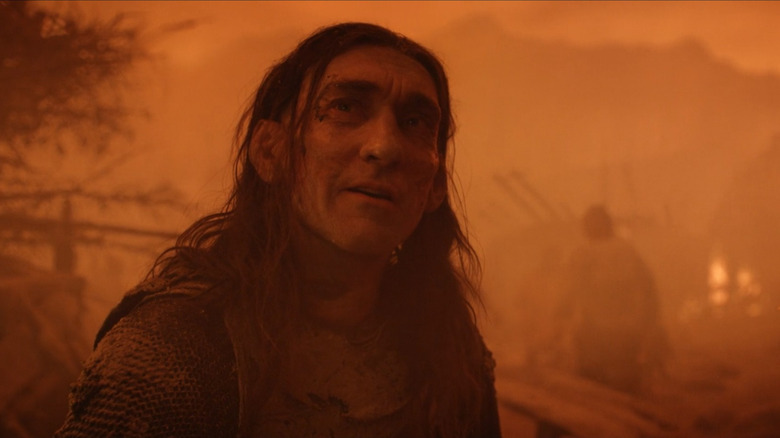Details About Adar In The Rings Of Power That Fans Should Know About
We may receive a commission on purchases made from links.
"The Lord of the Rings: The Rings of Power" introduced a few villains in its debut season — including the mysterious Mystics, the sniveling Waldreg, and, of course, Sauron himself. None of them, however, were quite as enigmatic as Adar, the self-proclaimed father of the Orcs. First appearing on screen at the end of the third episode, Adar proved to be one of the stand-out characters of the season, lending "The Rings of Power" a compelling and surprisingly sympathetic antagonist in lieu of the seemingly absent Dark Lord.
Of course, it didn't hurt that fans of the show delighted in speculating over his motives, his purpose, and his true identity. Where does he come from? What is his interest in the Southlanders? Is he an Elf or an Orc, or something in between? While the back end of the season offered some answers to these questions, it's clear that there's still a lot to be learned about this latest foe of the Free Peoples of Middle-earth. Here's everything you need to know about Adar in "The Lord of the Rings: The Rings of Power."
The rise of Oren
Adar's journey began in 2019 when Deadline reported that Joseph Mawle had been cast as "Oren," the lead villain in Amazon Studios' then-untitled "The Lord of the Rings" series. Further details were scant at best, though the outlet stated that Mawle would be appearing opposite Will Poulter's character, "Beldor," and Markella Kavenagh's "Tyra." Poulter, who The One Ring speculated might have played Elrond, later pulled out of the series, while Kavenagh ended up portraying Nori Brandyfoot.
At the time, many rightly believed that Oren was merely a production codename. It would have been fair to assume, then, that Mawle would be playing Sauron in "The Rings of Power" — after all, who else but the Dark Lord could possibly be described as the show's "lead villain"? In 2021, however, a leaked character sheet suggested that Oren's real name wasn't Sauron — it was Adar, and that he would be an "Elf, tortured, corrupted, turned into warlord." Although Adar would reappear in a handful more leaks during filming on the show, fans still knew precious little about the character. The only thing anybody knew for sure, it seemed, was the name of the man who would play him.
Joseph Mawle
According to an interview published by BusinessLive, Joseph Mawle grew up in Shipston-on-Stour, in Warwickshire, England. At 13 years old, Mawle was found to be so dyslexic that he was sent to a boarding school for children with special educational needs. It was at his new school that Mawle truly fell in love with acting. His dream career took a serious knock, however, when he developed labyrinthitis, an ear condition that left him 70 percent deaf and suffering from tinnitus.
Nevertheless, Mawle continued to pursue acting and eventually won a scholarship to the Bristol Old Vic theater school. He got his big break in "Soundproof," a 2006 TV movie about a deaf man wrongly accused of murder, and has since starred in shows and movies such as "The Passion," "Abraham Lincoln: Vampire Hunter," and "Ripper Street."
Arguably, Mawle's most famous role prior to "The Rings of Power" was Benjen Stark in "Game of Thrones." Mawle appeared in the HBO fantasy series for three episodes in Season 1 before returning in Seasons 6 and 7. Funnily enough, Mawle wasn't the only "Game of Thrones" alumnus to appear in "The Rings of Power" — Robert Aramayo, who plays Elrond, portrayed a younger version of Benjen's brother, Ned, in Season 6.
Adar revealed
"The Rings of Power" kept Adar almost entirely under wraps for the duration of the show's marketing campaign — so much so, in fact, that it would have been very easy to make it to his first episode without having any idea he would appear at all.
Our first glimpse of Adar came in February 2022, when Amazon Studios released (via The One Ring) 23 posters featuring each character's hands, costumes, and the occasional prop. The identities of the characters themselves, and the actors playing them, were kept secret. One of the most intriguing posters depicted somebody clad in black, spiked armor wielding a sinister sword. Some suggested this might be Sauron or one of the Nazgûl, while others argued it could belong to Morgoth. Notably, Adar was even omitted when the show's official Twitter account began revealing the names of the characters and actors behind each poster a few months later.
Then, in July, the marketing campaign kicked up another notch and Amazon began plastering buildings with enormous posters promoting the show. Adar was one of them. This was fans' first proper look at the Season 1 villain, although it didn't do much to relieve the rampant speculation that was growing around him.
Riddles in the dark
While it quickly became apparent that Joseph Mawle would not be playing Sauron, Morgoth, or one of the Nazgûl, the strange contradiction of his Elvish appearance and his villainous nature sparked plenty of theories about who he might otherwise be.
This speculation got off to an unnerving start when the YouTube account for Fellowship of Fans posted a video suggesting that Adar might be revealed to be one of Galadriel's brothers. This would obviously have been a bold break from Tolkien's canon, even by the standards of "The Rings of Power," and most fans are probably glad that it didn't turn out to be anywhere near the truth.
Another suggestion for Adar's identity was Maglor, the son of Fëanor who, in "The Silmarillion," steals a Silmaril from the Valar at the end of the First Age. After being scalded by the power or the jewel, Maglor casts his Silmaril into the sea and departs to wander the shores of Middle-earth, singing songs of despair and regret until the end of time. There's also Maeglin, the Elf who betrays the hidden city of Gondolin to Morgoth. During the Fall of Gondolin, Maeglin is defeated and cast down by the hero Tuor, but his "death" is ambiguous enough to have potentially warranted a return in the new series.
Moriondor
In "Udûn," Episode 6 of "The Rings of Power," Galadriel names Adar as one of the "Moriondor." Although this is a name concocted by the show's writing team, it comes from one of Tolkien's languages, Quenya, in which it is the plural form of "Dark One."
It's a fitting title. The show reveals that Adar was once an Elf, captured by Melkor (who would later be known as Morgoth) and twisted into one of the first of the Dark Lord's Orcs. This sounds like it could be an invention of "The Rings of Power," but it actually falls in line with one of the stories Tolkien considered for the origin of the Orcs.
The author changed his mind about the Orcs' beginnings at various stages in his life, suggesting at one point that Melkor might have crafted them out of stone and later theorizing that they were corrupted versions of Men at another. Perhaps the most famous origin, however — likely since it was mentioned in Peter Jackson's "Lord of the Rings" trilogy — states that a few of the very first Elves were hunted down and tortured into becoming servants of evil. This idea caused a number of theological headaches for Tolkien himself, but it's nevertheless fascinating to see it played out in a live-action adaptation, especially considering the further questions and implications it raises around Adar himself.
The blossoms of Beleriand
When Adar meets Arondir in Episode 4 of "The Rings of Power," he discovers that his captive was born in Beleriand, the large region that once existed in the northwest of Middle-earth. "By the mouth of the river?" Adar asks. "I went down that river once, when I was young. I remember the banks were covered in sage blossoms ... miles of them."
This moment is intriguing, although it arguably raises more questions than answers. There were a few major rivers in Beleriand, but the largest and most important was the Sirion, which ended at the Mouths of Sirion by the Bay of Balar. Another possibility is the Gelion, which bordered the region of Ossiriand — and where Arondir, as a Silvan Wood-Elf, was more likely to have been raised.
Either way, it's clear that Adar visited Beleriand at some point during his life. In his text "The Annals of Aman," Tolkien suggests that Melkor's first captives were acquired in Year of the Trees 1085, about 20 Valian years before the beginning of the Great Journey across Middle-earth and some 40 Valian years before the Elves entered Beleriand. This would mean that Adar likely visited the region much later, possibly during the First Age, as one of Morgoth's servants. It's a testament to the tragedy of Adar's character that, even after being twisted into Orcish form by the Dark Lord, he still saw the beauty in the flowers that lined the river.
An ancient being
Knowing what we do about Adar, it's also possible to figure out his age — which is mighty impressive even for an Elf. If we assume that Adar was indeed captured in Year of the Trees 1085 or thereabouts, that would mean he lived through the rest of that Year, or 415 Valian years — this equates to around 4,000 solar years. We can probably assume he wasn't stolen as a baby, either, and since the first Elves awoke in Y.T. 1050, Adar could have been anywhere up to about 300 solar years old when he was captured.
Adar would also have lived through the First Age as it happened after the rising of the Sun, which lasted around 600 years. Moreover, he has survived enough of the Second Age to make it to the events of "The Rings of Power" — because of the show's condensed timeline, it's hard to say how far into the Second Age we're supposed to be, although the show hints that Morgoth was defeated about 1,000 years prior to its first episode.
Add that all up, and it's entirely possible that Adar is around 6,000 years old when he appears in "The Rings of Power." That would make him not only the second-oldest character in the show, behind Sauron, but also one of the oldest living beings in Middle-earth.
Father of the Orcs
In "The Rings of Power," Adar is defined by his relationship with the Orcs. Adar isn't even his real name — it's simply the Sindarin word for "Father."
Adar's unique backstory offers "The Rings of Power" the opportunity to depict the Orcs in a whole new way. Notably, his first scene sees him comforting Magrot, an Orc who has been fatally wounded in a scuffle with Arondir. His eyes filled with tears, Adar caresses his dying "child" before plunging a knife into his chest and ending his suffering. The other Orcs then take away Magrot's body while chanting "Nampak uglursha," a phrase that some fans have speculated could mean "Do not fear death." It's a fascinating insight into the more human aspects of the Orcs, and one that is made all the more riveting thanks to Adar's presence.
It seems Joseph Mawle demonstrated as much respect for his Orcish children as Adar himself – according to an episode of "The Rings of Power" official podcast, Mawle would "bristle" when cast and crew members referred to them as "Orcs" rather than "Uruk," the word they use for themselves in Black Speech.
The great plan
Adar's role in the history of Middle-earth becomes apparent in Episode 6, "Udûn." After besieging the Southlanders and claiming the mysterious broken hilt in their possession, Adar and his Orcs come under attack by Galadriel, Elendil, and a company of Númenórean cavalry. While Adar flees into the woods, his lackey, Waldreg, takes the hilt to the watchtower of Ostirith and drives it into a ceremonial altar. A dam breaks and Ostirith's lake is drained into the tunnels constructed by Adar's laborers, flooding Orodruin with water and triggering the volcanic explosion that creates Mordor. It's all very dramatic, but does any of this happen in Tolkien's books?
You probably won't be surprised to hear that the answer is: no. Obviously, characters such as Adar and Waldreg were invented for the show, and the huge lake triggering the eruption of Mount Doom is new material, too. That said, the writers behind "The Rings of Power" have done a good job setting up a storyline that doesn't technically contradict anything in the author's works. For example, Tolkien wrote that Mordor was named as such before Sauron made it his home, while Mount Doom itself was said to have been created by Morgoth during his reign.
Sure enough, in "The Rings of Power," the Southlands is renamed Mordor before Halbrand makes his return as Sauron, while the existence of Waldreg's hilt and the Ostirith dam suggests that Orodruin had been given a purpose long before the Second Age began. Adar's plan may not be gospel as far as Tolkien is concerned, but it's not really heresy, either.
Making a monster
To create the right look for Adar, the crew behind "The Rings of Power" had to walk a fine line between Elf and Orc. In September 2022, SlashFilm spoke to Jamie Wilson, the show's head of prosthetics. Wilson explained that they made an effort to prevent Adar from appearing too monstrous. "It was important that we definitely kept the elfness there," he said, "but at the same time there is darkness creeping in, be it physical — because obviously, you can see he has been attacked or traumatized at some point — and also probably a mental darkness that has crept into his soul."
We can learn more about Adar from his costume, too. His spiked gauntlet has stoked speculation ever since it first appeared in that character poster back in February 2022, and while the show has yet to explain its origin, the reveal in "Udûn" that Adar "killed" Sauron suggests it might have once belonged to the nascent Dark Lord. Meanwhile, Adar's neck plate features the same river-like pattern as that worn by Gil-galad, offering a subtle yet fascinating insight into his Elvish past.
The return of the Dark Lord
Towards the second half of Season 1 of "The Rings of Power," it becomes clear that Adar's past is intertwined with the fate of Sauron. He tells Galadriel that he split his former master in two after becoming disillusioned by their ghoulish experiments on the Orcs, and becomes visibly angry at Waldreg after being mistaken for Sauron a few episodes earlier. Nevertheless, when Sauron's new form confronts Adar after the battle in the Southlands, Adar doesn't recognize him.
Joseph Mawle knew exactly who he was facing, however. In an interview with ScreenRant, Halbrand actor Charlie Vickers said that Mawle was one of the few people who knew his true identity. "I think when it came to filming that episode," Vickers explained, "Joseph knew, and we spent quite a lot of time working over our backstory based on information from the showrunners and things that we will see next season."
Vickers also elaborated more on that moment between Halbrand and Adar, suggesting that their mutual hostility is even greater than it appears. "It's a really complex and long-standing relationship that comes to a head in that moment," Vickers explained. "I think there's a huge part of Sauron, of Halbrand that's like, 'I look different, but goddamn, I want you to remember me, so you know it's me about to kill you.'"
Adar's doom
Not many people might have expected Adar to survive to the end of Season 1 of "The Rings of Power." It came as a pleasant surprise, then, to find him safe and well among his Orcs at the end of Episode 7, "The Eye." The last time we see him in Season 1, Adar is basking in his victory over the Númenóreans, ready to take up residence in his newly-founded home — Mordor.
You can safely bet that both Adar and Joseph Mawle will be returning to Middle-earth for Season 2, but don't expect things to stay so sweet for this wayward Elf. In Season 1's final scene, Halbrand, having revealed his true identity to Galadriel, returns to Mordor, ready to reclaim his throne as Middle-earth's number one villain. After the season ended, Charlie Vickers confirmed to TV Insider that Sauron will be causing a whole heap of trouble in Season 1 — and it stands to reason that Adar will be his first target. "I'm most looking forward to the season we're currently filming, where Sauron is just wreaking havoc," Vickers said. "He's just being Sauron, you know? It's a new phase for him."
While the established lore of "The Lord of the Rings" suggests that Sauron is destined to destroy his ancient enemy, if Season 1 of "The Rings of Power" is anything to go by, he might have a hell of a fight on his hands.
